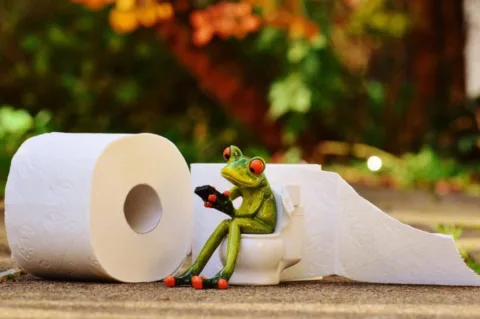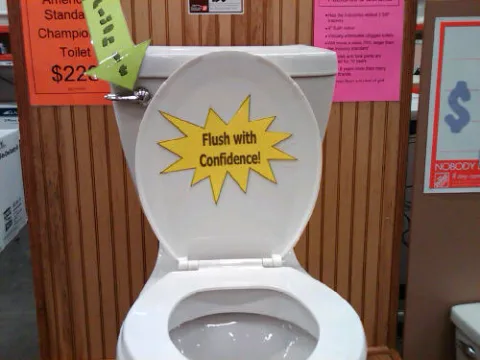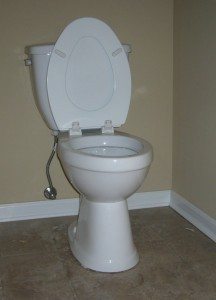Buying a new toilet might not be as easy as you think.
There are several things that you should take into consideration before you open your wallet — otherwise, you could be flushing your hard-earned cash down the toilet!
Following are a few questions to ask yourself before you head to the store to buy a toilet:
- Do I want an elongated toilet bowl or a round one? (yes, shape matters)
- What toilet color would be the best choice for my bathroom? (there are many toilet colors to choose from)
- Do I need/want an extra wide toilet seat? (wider is better for bigger bums)
- What’s the ideal toilet height? (comfort height is 16″ to 19″, standard height is 14″ to 15″)
- Do I want a single flush or dual flush toilet? (dual flush will save more water)
- What is the rough-in distance? (distance in inches from the bolts to the wall; most toilets are 12″, but there are also 10″ and 14″ distances)
- Do I want a gravity-assisted toilet tank or a pressure-assisted one? (gravity-fed models last longer)
- Which is better, a 1-piece toilet design or 2-piece? (2-piece toilets are the most common)
- Does the toilet meet WaterSense standards for water efficiency? (ideally, you want a toilet that meets High-Efficiency Toilet standards — or HET)
- Does this toilet pass some sort of flush test? (see MaP toilet flush ratings below)
Here are 15 things you need to know before you buy a toilet.
The Importance Of Toilet Flush Ratings
The flush test issue is a great question!!! In fact, it’s one of the most important questions you should ask. Actually, it’s a 2-parter:
- How much will the toilet flush?
- Does it get the job done using 1.6 gallons per flush (the legal limit) or less?
TIP: You might want to consider a high-efficiency toilet that uses 1.3 gallons/flush, 1.0 gallons/flush, or even 0.8 gallons/flush. The technology is there for a very efficient toilet these days!
You can find reliable flush test results, toilet flush ratings, and water efficiency criteria for a wide range of toilets here:
- WaterSense – in partnership with the U.S. Environmental Protection Agency; find toilets that meet their water-saving standards
- Maximum Performance (MaP) – the MaP performance rating began in response to complaints about the first low-flow toilets in the 1990s; the MaP rating is a standard that is widely accepted by plumbing manufacturers and consumers alike
- Consumer Reports – unbiased research in an effort to help consumers make the best decisions before buying household items
MaP Toilet Flush Ratings
Keep in mind, different toilet testing facilities use different products for fecal simulation.
For example, some testing firms and manufacturers will flush potatoes down the toilet to simulate capacity. That seems a bit ridiculous — because if you’ve got a potato-sized nugget exiting your body, you’ve got issues. Get real!
But Maximum Performance (MaP toilet testing) is a one-stop-shop of sorts that gives you all of the info you need. The best part is that it’s free to research toilets to your heart’s content.
I like the methods and protocol that MaP uses to test toilets for capacity:
- They make their own soybean paste (media).
- Then put it through an extruding device (I accidentally typed “exturding”…whoops!…maybe that’s what it should be called in this case) to create 6” cylinders.
- They put various amounts of soy paste media in a toilet and catch the soy material in a colander under the toilet when they flush it.
- They weigh the material to make sure it has all passed through.
- They end up with varying amounts of media that are flushed in order to record what a toilet will consistently flush without any issues.
The bottom line is you should look for a toilet that passes the 500 gram test.
While there is nothing wrong with limiting your interest to models that flush 1,000 grams, you may be doing yourself a disservice. The U.S. EPA’s WaterSense program sets the minimum flushing performance level at 350 grams (12 oz). This level represents approximately the 99th percentile – or, in other words, in 99 times out of 100 the actual mass flushed in a toilet is less than 350g. We feel that any toilet model that flushes 500 grams or more would provide exceptional flushing performance. What’s more, some of the most efficient, stylish, and cost-effective toilet models have MaP scores of less than 1,000g. — MaP Maximum Performance
They actually have toilet performance tests that flush up to 2 pounds of media! That’s a lot of yoohoo and exceeds what the average human will… well… you get the idea. After all, this is The FUN Times Guide to HomeBuilding… not The Gross Times Guide to HomeBuilding!
MaP toilet testing goes one step further by dropping the soy media in a specific spot in the toilet bowl to simulate real-life conditions. After the media is dropped into the bowl, they add 4 wads of toilet paper. Yes, there are photos of this procedure (be sure to scroll down).
Are you ready for this?… There are even videos of MaP toilet testing in action. WARNING: Visually, it’s kind of gross — but it’s as real as it’s going to get without using the real thing. I wouldn’t want this job… sorry!
By the way, any laboratory can perform MaP toilet testing, but there are strict terms and conditions that must be adhered to.
Occasionally, toilet manufacturers will make slight changes to toilet models that are sold through different retailers — this may alter the efficiency of the toilet that was tested.
MaP will perform field audits for the following reasons:
- There is evidence that toilets sold at retail outlets are materially different from the ones originally tested by a MaP-approved laboratory.
- Original MaP toilet testing was conducted more than 4 years previous.
- Consumer complaints suggest that a toilet model is performing well below the level indicated by its MaP rating score.
MaP wants the integrity of the results to remain intact and correct to the best of their knowledge.
How To Use MaP Toilet Ratings When Buying A Toilet
Figuring out which toilets have a good MaP rating is very easy to do.
Simply go to the MaP Toilet Search page and check off all the features you’re looking for in a toilet. Hit “search,” and there you have it — all of the toilets that meet your criteria.
See the latest MaP toilet flush ratings for more than 600 toilets! (Here’s how to read the MaP tables.)
Now, armed with all of that information, it really shouldn’t take that long to figure out which toilet meets your needs. The trouble will be locating the model you want in a store.
TIP: If you match the model number exactly as it appears in the ratings on the MaP site, you should be good to go… literally.







